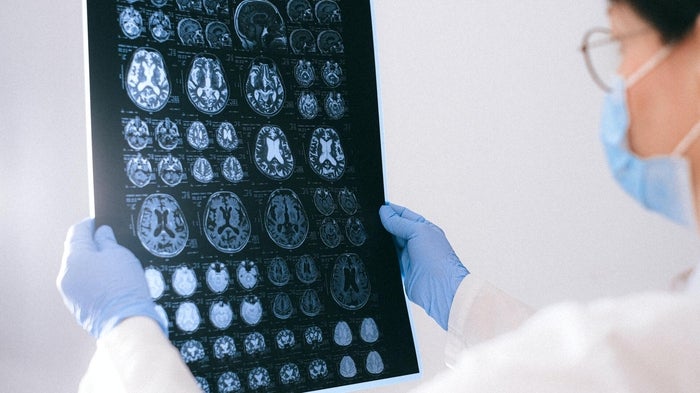
From cutting-edge cancer research to new frontiers in machine learning, here are twelve big research stories from the Faculty of Mathematics that you may have missed this year.
Winter:
Using machine learning to predict brain tumour progression (January 16)
Researchers at the University of Waterloo have created a computational model to predict the growth of deadly brain tumours more accurately. Researchers at the University of Waterloo and the University of Toronto have partnered with St. Michael’s Hospital in Toronto to analyze MRI data from multiple glioblastoma multiforme sufferers. They’re using machine learning to fully analyze a patient’s tumour, to better predict cancer progression.
OneButtonPIN increases security for blind and low-vision tech users (January 18)
Working closely with blind and low-vision (BLV) users, researchers at the University of Waterloo and the Rochester Institute of Technology have developed a new authentication method that could help BLV technology users more securely access their devices. The new method, OneButtonPIN, allows users to input PIN codes using a single large button and a series of haptic vibrations.
Computer scientists paint a picture of six decades of movies (March 9)
From the sepia tones of a Coen brothers film set in the Dust Bowl to a child’s red coat in Schindler’s List, filmmakers have long known the power of colour in movies. Now, computer scientists have analyzed 60 years of films to paint a picture of the past six decades in film. Researchers at the University of Waterloo used a technique called k-means clustering to analyze the trailers for more than 29,000 North American movies released between 1960 and 2019.
Time of day and patient’s sex may alter the effectiveness of blood pressure medication (April 19)
New research from a team based at the University of Waterloo suggests that the time of day and a patient's sex may alter the effectiveness of certain blood pressure medications. Anita Layton's team used mathematical models to simulate kidney function in male and female mice to assess the effectiveness of various kinds of diuretic drugs: loop diuretics, thiazide diuretics, and potassium-sparing diuretics.
Spring:
How secure are voice authentication systems really? (June 27)
Computer scientists at the University of Waterloo have discovered a method of attack that can successfully bypass voice authentication security systems with up to a 99% success rate after only six tries. Voice authentication – which allows companies to verify the identity of their clients via a supposedly unique “voiceprint” – has increasingly been used in remote banking, call centers and other security-critical scenarios.
Dreaming in technicolour (July 20)
A team of computer scientists and designers based out of the University of Waterloo have developed a tool to help people use colour better in graphic design. The tool, De-Stijl, uses powerful machine learning technology to suggest intuitive colour palettes for novice designers and inexperienced users.
Are you breaking your body clock? (August 17)
Researchers are using mathematical models to better understand the effects of disruptions like daylight savings time, working night shifts, jet lag or even late-night phone scrolling on the body’s circadian rhythms. The University of Waterloo and the University of Oxford researchers have developed a new model to help scientists better understand the resilience of the brain’s master clock: the cluster of neurons in the brain that coordinates the body’s other internal rhythms.
Acting fast when an epidemic hits (August 31)
A team of researchers at the University of Waterloo and Dalhousie University have developed a method for forecasting the short-term progression of an epidemic using extremely limited amounts of data. Their model, the Sparsity and Delay Embedding-based Forecasting model, or SPADE4, uses machine learning to predict the progression of an epidemic using only limited infection data.
Fall:
Using machine learning to close Canada’s digital divide (September 20)
Rural and remote communities in Canada often rely on satellites to access the internet, but those connections are fraught – with many glitches and service interruptions because the technology can be unreliable. The inequity in internet access between these communities and those who live in cities is an ongoing problem with myriad consequences for Canada’s economic productivity. A team of researchers from the University of Waterloo and the National Research Council (NRC) are tackling this long-standing issue using machine learning.
New 3D printed tumour model enables faster, less expensive and less painful cancer treatment (October 16)
An international team of interdisciplinary researchers has successfully created a method for better 3D modelling of complex cancers. The University of Waterloo-based team combined cutting-edge bioprinting techniques with synthetic structures or microfluidic chips. The method will help lab researchers more accurately understand heterogeneous tumours: tumours with more than one kind of cancer cell, often dispersed in unpredictable patterns.
Using mathematical modelling to save coral reefs (October 24)
A team of researchers at the University of Waterloo is using mathematical models to help determine the best strategies for saving coral reefs from climate change. As havens of biodiversity, coral reefs are some of the world's most important ecosystems – and some of the most vulnerable to the impacts of climate change. While the world's reefs face numerous intersecting threats, the Waterloo team focused on predicting outbreaks of crown-of-thorns starfish.
Unlocking the secrets of cells with AI (November 28)
Machine learning is now helping researchers analyze the makeup of unfamiliar cells, which could lead to more personalized medicine in the treatment of cancer and other serious diseases. Researchers at the University of Waterloo developed GraphNovo, a new program that provides a more accurate understanding of the peptide sequences in cells.